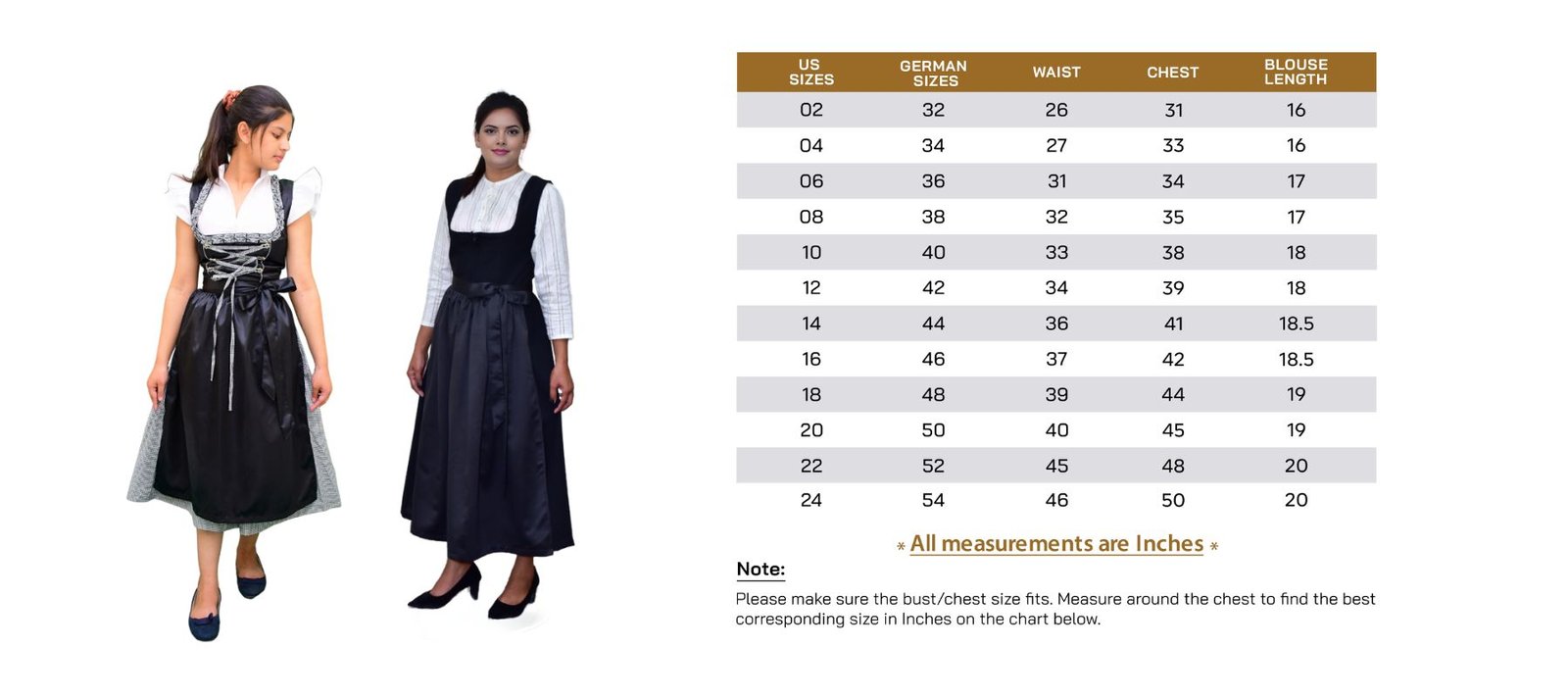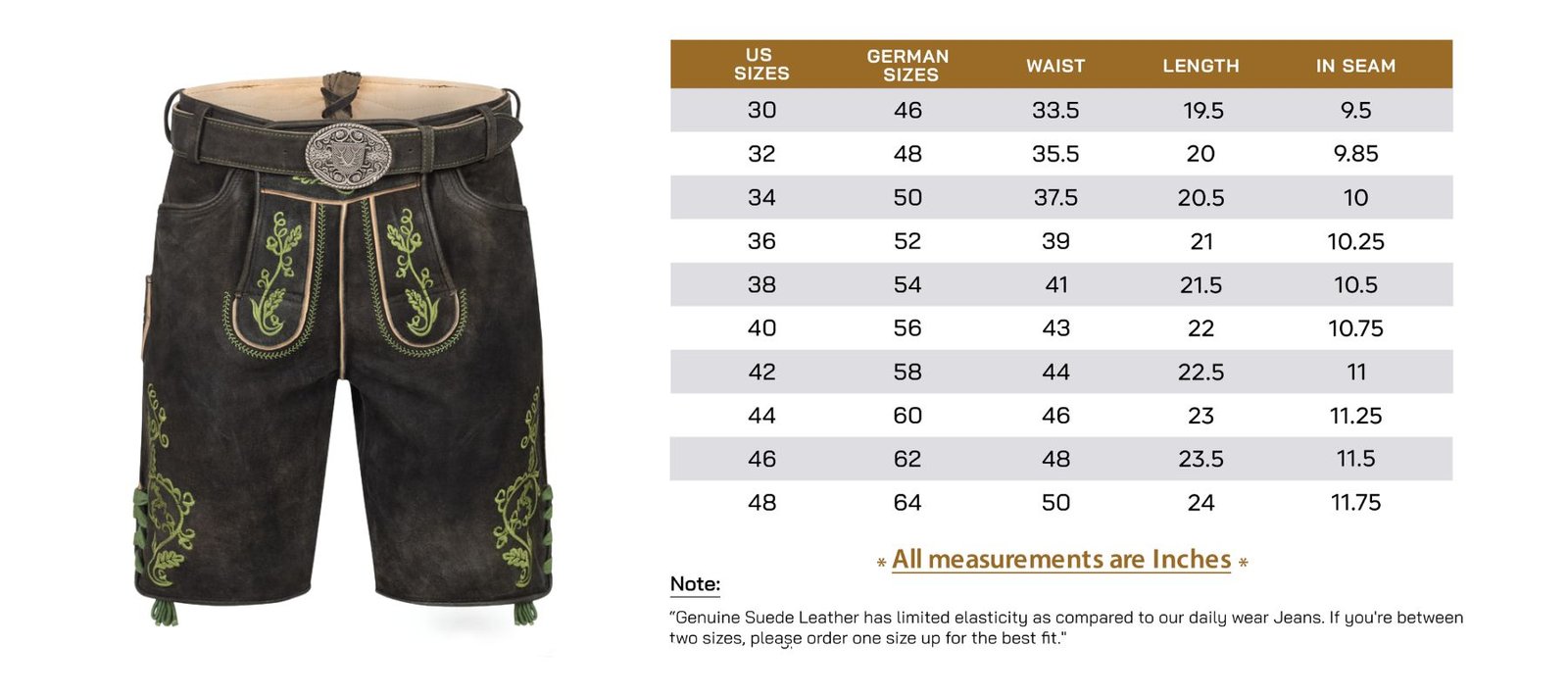Dirndl Dress Size Guide

Female Lederhosen

Men Lederhosen

Dirndl Dresses, Lederhosen, and Female Lederhosen: A Celebration of Bavarian Tradition and Modern Adaptation
Introduction
Nestled in the heart of European culture, Bavaria’s traditional attire—dirndl dresses and lederhosen—serves as a vibrant emblem of regional pride and historical legacy. Rooted in practicality and elevated to festive symbolism, these garments have transcended their Alpine origins to become global icons, particularly through Oktoberfest. This exploration delves into the rich history, intricate craftsmanship, and evolving styles of dirndls, male lederhosen, and the emerging trend of female lederhosen, revealing how tradition harmonizes with contemporary fashion.
Dirndl Dresses: The Quintessence of Alpine Femininity
Historical Roots
The dirndl, derived from the Austro-Bavarian word Dirn (meaning “young woman”), began as humble workwear for 19th-century servants and peasants. Its simple design—a durable dress with an apron—allowed ease of movement for labor. By the late 1800s, urban elites romanticized rural life, adopting the dirndl as high fashion. This “Trachtenmode” (traditional costume trend) solidified the dirndl’s status as a cultural staple, blending utility with elegance.
Anatomy of a Dirndl
A traditional dirndl comprises four elements:
Bodice: Tight-fitting, often boned, emphasizing the waist.
Blouse: White with puff sleeves, adding a touch of modesty.
Skirt: Full and knee-length, crafted for twirling.
Apron: Tied at the waist, symbolizing marital status—left (single), right (married), center (virgin), or back (widowed).
Fabrics range from rustic linen for everyday wear to luxurious silk for festivities. Modern dirndls experiment with bold colors, floral prints, and even metallic threads, while maintaining structural integrity.
Cultural Symbolism and Modern Revival
Dirndls are more than attire; they are narratives of identity. Regional variations exist: muted tones in Tyrol, vibrant hues in Bavaria. Today, they star at Oktoberfest, weddings, and folk festivals. Designers like Vivienne Westwood and Karl Lagerfeld have reimagined dirndls, merging corseted silhouettes with avant-garde elements. Despite modern twists, the dirndl remains a testament to heritage, its apron knots whispering age-old social codes.
Lederhosen: Masculine Craftsmanship and Alpine Pride
From Workwear to Cultural Icon
Lederhosen (German for “leather breeches”) originated in the 18th century as rugged attire for Alpine laborers and hunters. Crafted from deer or goat leather, their durability withstood harsh climates. By the 19th century, they became a symbol of Bavarian identity, promoted by King Ludwig II to foster national pride. Urbanization nearly relegated them to history until the 20th-century Trachten revival reignited their popularity.
Design and Detailing
Types: Kurze Lederhosen (short) for summer revelry; Kniebundhosen (knee-length) for cooler weather.
Craftsmanship: Vegetable-tanned leather, aged for suppleness. Artisans hand-stitch seams and embellish with intricate embroidery—edelweiss, oak leaves, or hunting motifs.
Accessories: Paired with suspenders (Hosenträger), wool socks, Haferl shoes, and checkered shirts.
Cultural Resonance
Lederhosen embody Bavarian Gemütlichkeit (conviviality). Worn at beer gardens, festivals, and family gatherings, they signify camaraderie. Modern iterations feature minimalist designs or edgy details like zippers, yet purists uphold traditional methods, ensuring each pair tells a story of craftsmanship.
Female Lederhosen: Redefining Tradition
Emergence of a Modern Trend
Historically, lederhosen were male-exclusive, but 21st-century shifts in gender norms and fashion spurred female adaptations. Women sought practicality and inclusivity in traditionally male spaces like Oktoberfest, leading to tailored lederhosen that blend femininity with rugged charm.
Design Innovations
Female lederhosen prioritize fit and flair:
Cut: Higher waistlines, tapered legs, and shorter lengths.
Embellishments: Delicate floral embroidery, lace trim, or rhinestones.
Styling: Paired with frilly blouses, corsets, or Dirndl-inspired aprons.
Cultural Reception
While some traditionalists critique female lederhosen as inauthentic, many embrace them as progressive. Urban festivals and LGBTQ+ communities particularly champion this trend, viewing it as a fusion of heritage and individuality. Designers like Lola Paltinger and Gwandhaus now offer bespoke options, ensuring women honor tradition without sacrificing self-expression.
Conclusion
Dirndls and lederhosen are more than relics; they are living narratives adapting to modern sensibilities. From the dirndl’s journey from servant garb to haute couture to lederhosen’s evolution into unisex fashion, these garments epitomize cultural resilience. As Oktoberfest draws millions worldwide, donning Tracht becomes a universal celebration of history, community, and the enduring allure of Bavarian tradition. In every stitch and seam, dirndls and lederhosen whisper the past while dancing boldly into the future.
